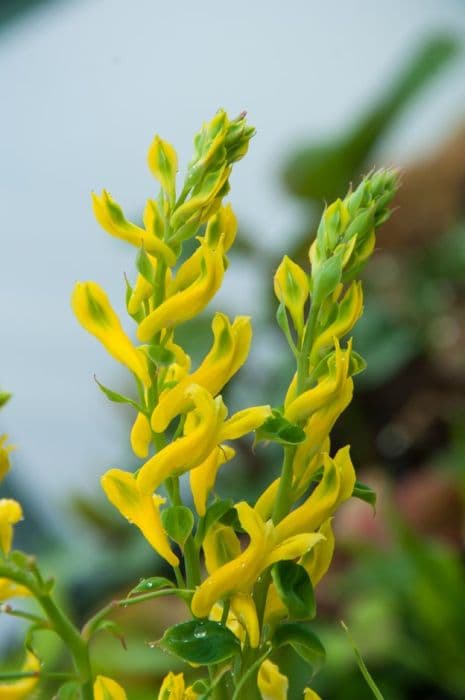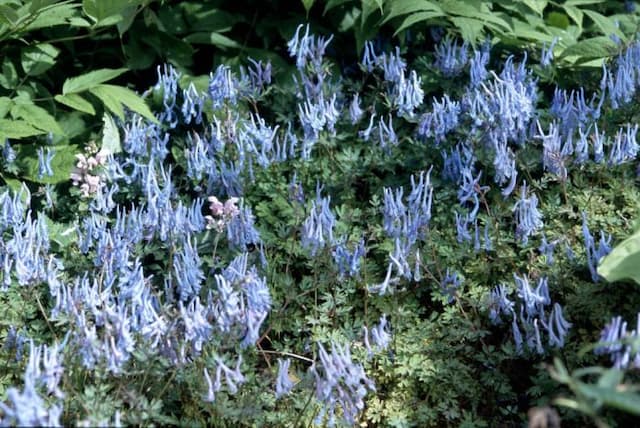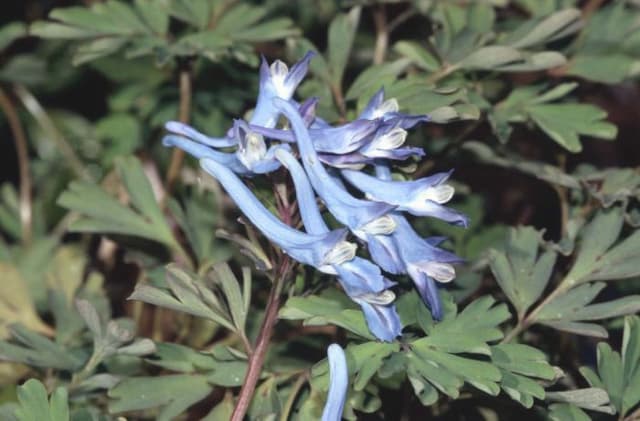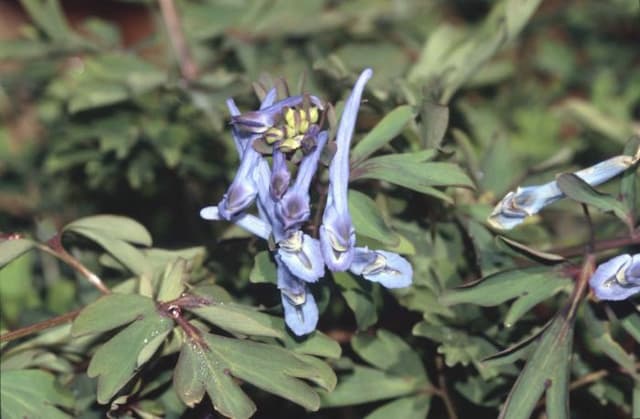Bleeding Heart Vine Dactylicapnos macrocapnos

ABOUT
Dactylicapnos macrocapnos, commonly known as the Yunnan goldthread, is a climbing plant recognized for its distinctive floral and foliage characteristics. The plant’s leaves are compound, with a feathery appearance, presenting themselves in a green color that can turn bluish-green depending on the light exposure. The foliage provides a delicate backdrop to its most striking feature: the flowers. The flowers of the Yunnan goldthread are noteworthy for their unusual shape, resembling small, inflated balloons or lanterns that dangle elegantly from the vine. They are typically a soft, creamy-yellow color. The blooms may have subtle vein patterning that can add depth and texture to their appearance. These charming flowers give the plant an almost whimsical look as they sway gently in the breeze. The plant also produces fruit that takes the form of a pod. These small pods follow after the flowering period and can add further interest as the plant transitions through its growth cycle. It's important to note that the Yunnan goldthread is a climber, which means it will often be seen supported by structures or other plants in its natural habitat, adding vertical interest to the spaces it inhabits. The textural contrast between the feathery leaves and the unique flowers, combined with its climbing nature, makes the Yunnan goldthread a captivating addition to any garden where it can be draped over fences, trellises, or allowed to climb up other supports, creating a visually appealing display.
About this plant
 Names
NamesFamily
Papaveraceae.
Synonyms
Large-fruit Bonnet, Large-fruited Dicentra.
Common names
Dicentra macrocapnos, Dactylicapnos volubilis, Dactylicapnos scandens, Capnorchis volubilis.
 Toxicity
ToxicityTo humans
Dactylicapnos macrocapnos, commonly known as the Yunnan bleeding heart, has not been extensively studied for its toxicity to humans. Therefore, detailed information about its potential toxicity and symptoms of poisoning is limited. However, as it belongs to the family Papaveraceae, which contains many species with known toxic compounds, it is advisable to avoid ingesting any part of the Yunnan bleeding heart and to be cautious when handling it. If you suspect poisoning from this plant, seek medical attention promptly.
To pets
Dactylicapnos macrocapnos, known as the Yunnan bleeding heart, has not been widely researched for its effects on pets. Nevertheless, caution should be exercised because other members of the Papaveraceae family are known to contain toxic substances. Since the exact toxicity of the Yunnan bleeding heart to pets is not well-documented, it is best to prevent pets from ingesting any part of the plant. If you believe your pet has consumed Yunnan bleeding heart, contact a veterinarian as soon as possible.
 Characteristics
CharacteristicsLife cycle
Perennials
Foliage type
Deciduous
Color of leaves
Green
Flower color
Yellow
Height
6 feet (1.83 meters)
Spread
6 feet (1.83 meters)
Plant type
Climber
Hardiness zones
7
Native area
Asia
Benefits
 General Benefits
General Benefits- Aesthetic Appeal: Dactylicapnos macrocapnos, commonly known as the larger Himalayan bleeding-heart, adds visual interest to gardens with its distinctive heart-shaped flowers and vine-like growth.
- Attracts Pollinators: The plant attracts bees, butterflies, and other pollinating insects, contributing to the health and productivity of the ecosystem.
- Habitat Enrichment: As part of a diverse planting scheme, larger Himalayan bleeding-heart provides shelter and food for various small wildlife species.
- Soil Improvement: The leaf litter and root system can enhance soil structure and fertility over time by adding organic matter.
- Garden Design: It can be used effectively in landscape design for vertical interest or to cover unsightly structures with its climbing habit.
- Educational Value: As an interesting species, it can be used for educational purposes in botanic gardens and horticultural programs to study plant growth and morphology.
- Cultural Significance: The plant may have cultural or symbolic value in certain communities or as part of traditional gardening practices.
 Medical Properties
Medical PropertiesThis plant is not used for medical purposes.
 Air-purifying Qualities
Air-purifying QualitiesThis plant is not specifically known for air purifying qualities.
 Other Uses
Other Uses- The climbing vine of the Dactylicapnos macrocapnos, commonly known as the "bigfruit bleeding heart," can be used to create natural screens or cover unsightly structures in a garden with its foliage and flowers.
- The seed pods of this plant may be used in dried floral arrangements for a unique textural element due to their interesting shape.
- Fibers from the stems of the bigfruit bleeding heart could potentially be researched for use in making paper or textiles, as with many fibrous plants.
- During times of food scarcity, some cultures might consider the plant's tuberous roots as an emergency food source, after ensuring they are safe and non-toxic for consumption.
- The plant could be used in educational settings such as botanical gardens to demonstrate plant growth habits, like twining and climbing mechanisms used by vines.
- Bigfruit bleeding heart's nectar-rich flowers could be used to attract and sustain beneficial insect populations, such as pollinators, in an ecological garden or permaculture design.
- The dried vines of the plant may serve as natural craft materials for making wreaths and other decorative items.
- Due to its distinctive appearance, it could be used as a subject for botanical illustration, photography, or as inspiration for artists and designers.
- The plant can be used in a compost pile or green waste recycling to return organic matter and nutrients back to the soil as it decomposes.
- Though not a common use, the leaves may serve as a natural dye source, potentially yielding color for fabrics and textiles when processed appropriately.
Interesting Facts
 Feng Shui
Feng ShuiThe Dactylicapnos macrocapnos, commonly known as the Yunnan bleeding heart, is not used in Feng Shui practice.
 Zodiac Sign Compitability
Zodiac Sign CompitabilityThe Yunnan bleeding heart is not used in astrology practice.
 Plant Symbolism
Plant Symbolism- Intrigue: Dactylicapnos macrocapnos, commonly known as Yunnan Bleeding-heart, possesses unusual heart-shaped flowers, which can symbolize the mysterious and compelling allure found within the complexities of love.
- Compassion: As with other members of the Bleeding-heart family, its pendulous blooms are seen as an embodiment of empathy and open-heartedness, reminding us of the need to be kind and nurturing to others.
- Romantic Love: The distinctive shape of the Yunnan Bleeding-heart's flowers is reminiscent of the iconic heart symbol, universally understood as an expression of romantic love and devotion.
- Sensitivity: The delicate appearance of the flowers can represent a sensitive nature, suggesting a person who is easily moved by emotional undercurrents and attuned to the subtleties of feeling.
- Grace: The elegant droop of the plant’s stems and flowers convey a sense of grace and poise, often seen as an attribute to strive for in various aspects of life and behavior.
 Water
WaterThe Climbing Bleeding Heart should be watered deeply once a week, allowing the water to penetrate the soil to a depth of at least an inch. During the growing season, from spring through summer, aim to provide about one gallon of water weekly per plant. If the weather is particularly dry or hot, check the soil moisture level more frequently and water when the top inch of soil feels dry to the touch. Reduce watering in the fall and further in the winter when plant growth slows down.
 Light
LightThe Climbing Bleeding Heart thrives in partial shade, ideally receiving filtered sunlight or morning sun with afternoon shade. The best spot for this plant would be in an area that mimics its natural woodland habitat, protected from the intense midday sun. Avoid full sun locations, as this can lead to scorched leaves and stress on the plant.
 Temperature
TemperatureThe Climbing Bleeding Heart prefers a temperate climate with temperatures ranging between 50°F and 75°F. It can survive minimum temperatures down to around 32°F, but frost can damage the plant. The ideal temperature range is crucial for this plant's health, and it should be protected from extreme cold and heat.
 Pruning
PruningPruning Climbing Bleeding Hearts is necessary to maintain shape, remove dead or damaged vines, and encourage new growth. The best time to prune is in late winter or early spring before new growth begins. Cut back old stems to a healthy set of buds to stimulate the plant, and repeat the process if necessary after the main flowering period to keep the plant looking tidy.
 Cleaning
CleaningAs needed
 Soil
SoilClimbing Bleeding Heart (Dactylicapnos macrocapnos) thrives in a soil mix that is well-draining with a good amount of organic matter. A mix of loam, peat, and sand or perlite is often recommended to ensure proper drainage and aeration. Soil pH should be slightly acidic to neutral, around 6.0 to 7.0, for the plant to flourish.
 Repotting
RepottingClimbing Bleeding Heart should be repotted every 2 to 3 years to refresh the soil and accommodate root growth. It's best repotted in spring before the onset of new growth.
 Humidity & Misting
Humidity & MistingClimbing Bleeding Heart prefers high humidity levels, generally around 60-80%. Avoid placing it in dry environments, as it benefits from moist, humid air which mimics its native woodland habitat.
 Suitable locations
Suitable locationsIndoor
Provide bright light, high humidity.
Outdoor
Use rich, moist soil, partial shade.
Hardiness zone
8-10 USDA
 Life cycle
Life cycleDactylicapnos macrocapnos, commonly known as the Large-fruited chain poppy, begins its lifecycle as a seed, typically requiring a period of dormancy before germination can occur. Upon germination, the seedling emerges and establishes a small root system and a few leaves, entering the vegetative growth phase where it develops more foliage and stems. During its growth, it climbs and supports itself on surrounding vegetation using tendrils. After reaching maturity, the Dactylicapnos macrocapnos produces flowers which, upon successful pollination, set fruit in the form of capsules containing numerous seeds. These seeds are dispersed by various means, including gravity and animal-mediated transport. Eventually, the adult plant will senesce and die, completing its lifecycle, with the seeds lying dormant until conditions are suitable for the next generation to begin this process anew.
 Propogation
PropogationPropogation time
Spring-early summer
Dactylicapnos macrocapnos, also known as Yunnan Goldcup, is a climbing plant often propagated from seeds. The most popular method of propagation for this plant is by sowing seeds in the spring after the danger of frost has passed. To propagate, one would generally soak the seeds for 24 hours in warm water to soften the seed coat, which can enhance germination rates. After soaking, the seeds can be sown in a well-draining soil mix, at a depth of about 1/4 inch (around 6 millimeters), and kept moist until germination occurs. It's important to place the seed tray in a warm, bright location, but out of direct sunlight, to provide the ideal conditions for the seeds to sprout. Once seedlings are large enough to handle, they can be transplanted into individual pots and eventually moved outdoors.









